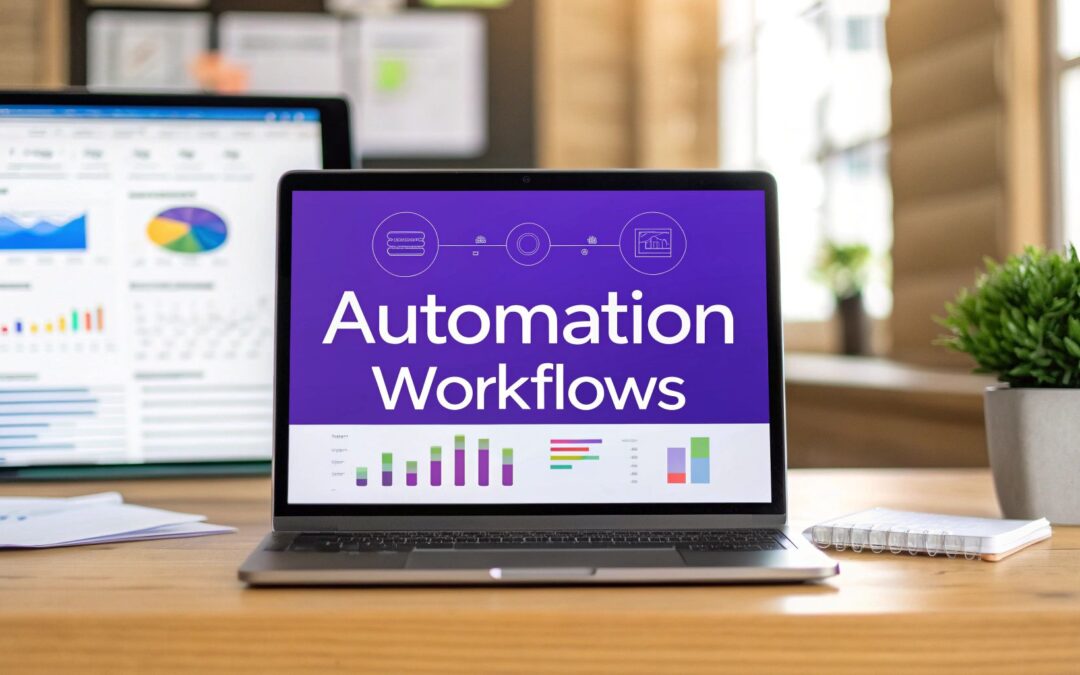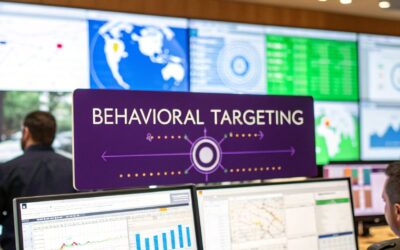Ready to move beyond basic email blasts and unlock true marketing efficiency? The key lies in strategic automation. In a world where personalization is paramount, generic campaigns fall flat. Marketing automation allows you to deliver the right message to the right person at the exact right time, turning casual visitors into loyal customers. But where do you start? The theory is great, but practical application is where the magic happens. Many of the most effective automations are triggered by user behavior and can be enhanced with dynamic elements; for instance, learning how to add countdown timers to your website to boost urgency and sales can significantly amplify the impact of a time-sensitive offer within a workflow.
This guide provides 10 powerful marketing automation workflow examples, complete with strategic breakdowns, actionable tips, and insights on how to implement them, especially for Divi users leveraging tools like Divi Areas Pro. We won't just list ideas; we'll dissect the "why" behind each workflow, offering replicable blueprints for growth. We'll break down everything from welcoming new subscribers and recovering abandoned carts to re-engaging dormant users and rewarding loyal customers. Consider this your tactical playbook for building a smarter, more effective marketing engine that works for you 24/7.
1. Lead Nurturing Workflow
A lead nurturing workflow is an automated sequence designed to guide potential customers through the sales funnel. Instead of generic blasts, this workflow delivers targeted content based on a prospect's specific behaviors and engagement level. The goal is to build a relationship, establish trust, and educate the lead until they are ready to make a purchase decision. This is a foundational strategy in any modern marketing automation plan.
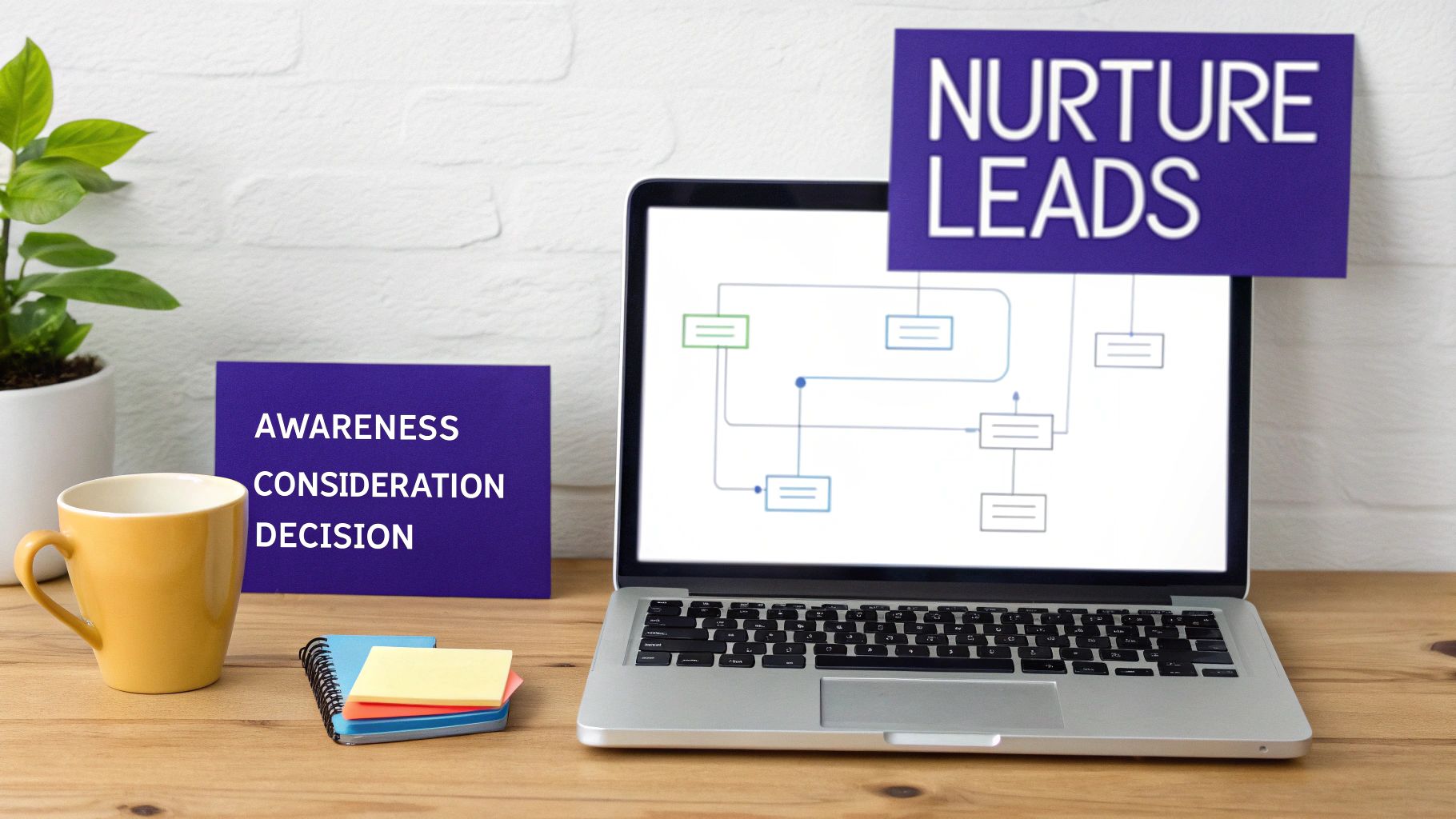
Strategic Breakdown
This type of workflow excels at moving prospects from initial awareness to the final decision stage. For example, a B2B SaaS company might use HubSpot to send an introductory email when a user downloads a whitepaper. If the user clicks a link in that email, a follow-up is triggered a few days later with a relevant case study. This behavior-driven approach, a key element of effective email marketing campaigns, ensures communication is always timely and relevant.
Actionable Takeaways
To implement this effectively, focus on segmentation and triggers.
- Segment Leads: Group prospects by buyer persona, industry, or the specific content they downloaded. This allows for highly personalized messaging.
- Use Behavioral Triggers: Trigger emails based on actions like website visits, link clicks, or content downloads rather than just time delays.
- Implement Lead Scoring: Assign points to different actions. A prospect who views your pricing page is more "sales-ready" than someone who only reads blog posts.
- Vary Your Content: Mix educational content like blog posts with trust-building assets like testimonials and case studies to address different needs along the buyer's journey.
2. Welcome Series Workflow
A welcome series workflow is an automated sequence of emails sent immediately after a new user subscribes to your list or creates an account. Its primary purpose is to make a powerful first impression, set clear expectations, and begin building a strong, lasting relationship. This initial interaction is critical for capitalizing on the subscriber's peak interest and guiding them toward deeper engagement. It's one of the most effective marketing automation workflow examples for boosting long-term loyalty.
Strategic Breakdown
This workflow excels at transforming new, curious subscribers into engaged community members. For instance, Slack’s onboarding series doesn’t just say "welcome"; it delivers a multi-email sequence that guides users through key features, ensuring they experience the platform's value firsthand. This strategic approach reduces early churn and increases user activation by providing immediate, tangible benefits and educational content when motivation is highest. The goal is to confirm the user made the right choice by signing up.
Actionable Takeaways
To build a high-impact welcome series, focus on immediacy and value.
- Send Immediately: Trigger the first email within minutes of signup. Delays can lead to lost interest and lower open rates.
- Provide Immediate Value: Include an incentive in the first email, such as a discount code, a free resource, or exclusive content, to reward the user for subscribing.
- Set Expectations: Clearly communicate what kind of content they will receive and how often. This builds trust and reduces unsubscribe rates.
- Introduce Your Brand: Use the series to tell your brand's story, share your mission, and introduce key team members to create a human connection.
3. Re-engagement Workflow
A re-engagement workflow is an automated campaign designed to win back inactive subscribers or customers who have stopped interacting with your brand. Instead of letting these contacts go cold, this workflow uses a series of targeted emails with special offers or reminders to rekindle their interest. The primary goals are to boost engagement, recover potentially lost revenue, and maintain a healthy, active email list. This is a crucial component of any long-term marketing plan.
Strategic Breakdown
This workflow is essential for subscription services and e-commerce platforms looking to reduce churn and improve lifetime value. For example, a streaming service like Netflix might automatically trigger a "We miss you" email 60 days after a user's subscription lapses, offering a special one-month discount to return. This proactive approach turns inactivity into an opportunity, forming a key part of effective customer retention strategies that are vital for sustainable growth. It's a prime example of using automation to maintain valuable relationships.
Actionable Takeaways
To build a powerful re-engagement workflow, focus on timing and value.
- Define Inactivity: Clearly set your trigger. Is a user inactive after 60, 90, or 180 days of no purchases or email opens? This will depend on your sales cycle.
- Lead with a Strong Offer: A compelling, time-sensitive incentive (like 20% off or a free gift) is often the most effective way to encourage a return.
- Personalize the Message: Use emotional or nostalgia-based subject lines. Segment your inactive list by past purchase history to send highly relevant offers.
- Include a Final Opt-Out: The last email in your sequence should give users an easy way to unsubscribe. This cleans your list, improves deliverability, and ensures you're only marketing to an engaged audience.
4. Abandoned Cart Recovery Workflow
An abandoned cart recovery workflow is a critical automated sequence for e-commerce businesses. It triggers when a customer adds items to their online shopping cart but leaves the website without completing the purchase. The primary goal is to re-engage these high-intent shoppers by reminding them of their items, addressing potential barriers to purchase, and motivating them to finalize the transaction. This is one of the highest-impact marketing automation workflow examples for boosting revenue.
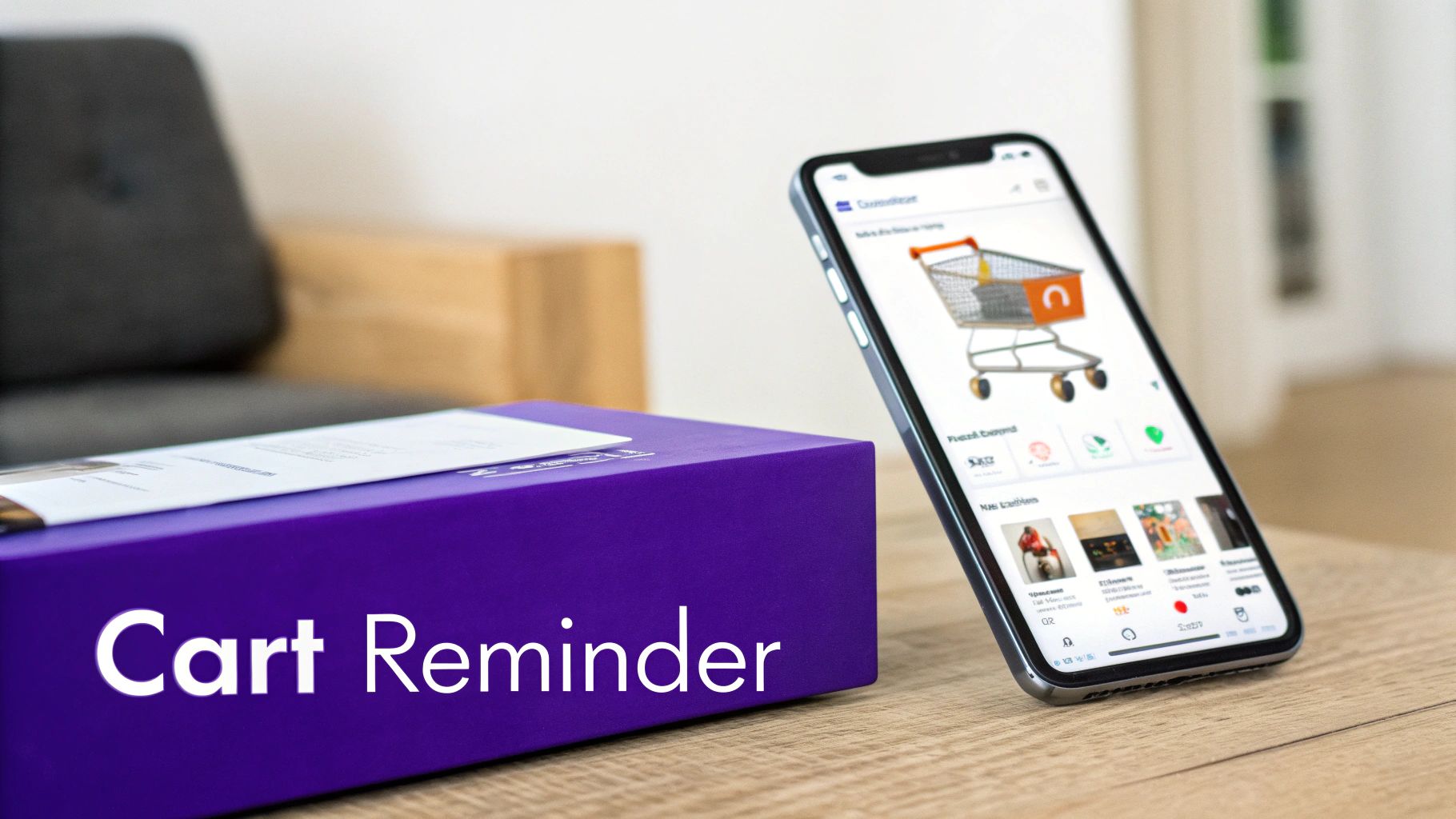
Strategic Breakdown
This workflow directly targets lost revenue by communicating with customers who have already shown clear purchase intent. For instance, a Shopify store using Klaviyo can automatically send the first reminder email within an hour, featuring images of the exact products left behind. A second email 24 hours later might introduce a sense of urgency, while a third email after 72 hours could offer a small discount as a final incentive. This timed, multi-touch strategy effectively overcomes common reasons for abandonment like distraction or unexpected costs.
Actionable Takeaways
To build a high-converting recovery sequence, timing and personalization are key.
- Optimize Timing: Send the first email within 1 hour, a second at 24 hours, and a third at 48-72 hours. This cadence keeps your brand top-of-mind without being intrusive.
- Personalize Content: Always include the customer's first name and dynamically insert images, prices, and direct links to the products in their cart.
- Introduce Urgency: Use messaging like "Your items are selling fast" or "Your cart expires soon" to encourage immediate action. A time-sensitive discount can also be highly effective.
- Remove Friction: Ensure the email links directly back to a pre-populated cart. You can explore further tactics for transforming abandoned carts into sales with popups to enhance this strategy.
5. Birthday/Anniversary Workflow
A birthday or anniversary workflow is a highly personalized automated campaign triggered by significant customer dates. These workflows celebrate milestones like a customer's birthday, the anniversary of their first purchase, or their membership sign-up date. The goal is to foster an emotional connection, strengthen loyalty, and drive repeat business by making the customer feel valued and recognized on a personal level. It's a classic example of using data to create timely, delightful experiences.
Strategic Breakdown
This type of workflow excels at customer retention and reinforcing brand loyalty. For instance, a retailer like Sephora automatically emails members of its Beauty Insider program a few days before their birthday with an offer for a free gift. This not only encourages a store visit or online purchase but also strengthens the perceived value of the loyalty program. The automation is simple: the trigger is a date field in the customer's profile, and the action is a pre-designed, personalized email sequence.
Actionable Takeaways
To implement this effectively, focus on personalization and a generous offer.
- Collect Dates Naturally: Add an optional "Birthday" field to your sign-up or account-profile forms. Never make it mandatory.
- Offer More Than a Discount: A genuine gift, exclusive access, or a special experience often feels more personal and valuable than a simple percentage off.
- Time It Right: Send the initial email a few days before the actual date to build anticipation. A reminder on the day of can also be effective.
- Personalize Beyond the Name: Reference their loyalty status or past purchases to make the message feel unique. For example, "To celebrate your 3rd anniversary as a member…"
- Provide a Flexible Redemption Window: Give customers a reasonable timeframe, like 30 days, to redeem their offer. This accommodates their schedule and increases redemption rates.
6. Post-Purchase Follow-up Workflow
A post-purchase follow-up workflow is an automated sequence that begins the moment a customer completes a transaction. This critical process moves beyond a simple order confirmation to enhance the customer experience, encourage product adoption, and foster long-term loyalty. The goal is to reassure the customer of their purchase, provide immediate value, and open the door for future engagement and repeat business.
Strategic Breakdown
This workflow's power lies in its ability to reduce buyer's remorse and turn a one-time buyer into a brand advocate. For example, a direct-to-consumer brand like Warby Parker automates shipping notifications, but also follows up with styling tips relevant to the frames purchased. This proactive communication provides value beyond the transaction itself, making customers feel supported and confident in their decision. This sequence is one of the most effective marketing automation workflow examples for maximizing customer lifetime value.
Actionable Takeaways
To build a successful post-purchase sequence, focus on timely, value-driven communication.
- Send Immediate Confirmation: Trigger an order confirmation email within five minutes of purchase to provide instant reassurance and peace of mind.
- Time Your Follow-ups: Schedule emails based on the product journey. Send shipping tracking when the item leaves the warehouse and a setup guide a day before it arrives.
- Request Feedback Strategically: Ask for a product review or feedback 2-3 weeks after delivery, giving the customer enough time to form a genuine opinion.
- Segment by Product: Personalize the follow-up content based on the specific item purchased to provide relevant usage tips or cross-sell complementary products.
7. Event-Triggered Workflow
An event-triggered workflow is an automated sequence that launches in direct response to a specific user action or behavior. Unlike time-based campaigns, these workflows are initiated in real-time by events like a website visit, form submission, or content download. The primary goal is to deliver a highly relevant and timely message at the exact moment a user shows interest, maximizing engagement by capitalizing on their immediate intent. This makes it a cornerstone of responsive marketing automation strategies.
Strategic Breakdown
This workflow excels at creating a one-to-one conversational feel with your audience. For example, a real estate agency can use this to automatically send neighborhood details and similar listings the moment a user views a specific property on their site. This immediate, context-aware follow-up provides value and keeps the user engaged with relevant information. Similarly, an e-commerce store can trigger an email with product details or a special offer seconds after a user views a product page three times in a single session, a clear indicator of high interest.
Actionable Takeaways
To build effective event-triggered workflows, focus on identifying high-intent actions.
- Define Clear Triggers: Isolate specific, meaningful user actions that signal intent, such as viewing a pricing page or downloading a case study, to serve as your automation triggers.
- Use If/Then Logic: Implement conditional branching to create more sophisticated paths. For instance, if a user downloads a whitepaper and is from the healthcare industry, send a relevant case study.
- Combine Triggers: Create advanced workflows by combining multiple triggers. For example, trigger a special offer only when a user has visited a product page more than twice and added an item to their cart.
- Implement Frequency Caps: To avoid overwhelming users, set limits on how often a single person can receive a triggered message within a specific timeframe.
8. Lead Scoring and Qualification Workflow
A lead scoring and qualification workflow is a system that automatically assigns points to prospects based on their attributes and actions. This process quantifies a lead's sales-readiness by tracking behaviors like website visits, email opens, and content downloads, alongside demographic data like job title or company size. Once a lead reaches a predefined score threshold, they are automatically qualified and routed to the sales team, creating a seamless handoff between marketing and sales.
Strategic Breakdown
This workflow is crucial for prioritizing sales efforts and ensuring that representatives focus on the most promising leads. For instance, a technology company using Salesforce might assign 10 points for visiting the pricing page, 5 points for downloading a whitepaper, and 20 points for having a "Director" level job title. When a lead's score surpasses 100, the system automatically creates a task for a sales rep to follow up. This data-driven approach removes guesswork, increases efficiency, and aligns marketing activities directly with revenue goals.
Actionable Takeaways
To build an effective lead scoring system, focus on collaboration and continuous refinement.
- Define Your SQL: Work with your sales team to establish a clear, universally agreed-upon score threshold for a Sales-Qualified Lead (SQL).
- Use Both Behavioral and Demographic Data: Combine engagement signals (behavioral) with "fit" signals like industry or company revenue (demographic) for a more accurate profile.
- Implement Negative Scoring: Assign negative points for actions that indicate a poor fit, such as a student email address or activity from a competitor.
- Review and Adjust Regularly: Analyze which scored leads convert into customers and adjust point values quarterly to refine the model's accuracy.
9. Referral Program Workflow
A referral program workflow automates the process of turning your existing customers into a powerful acquisition channel. It incentivizes them to refer friends or colleagues by managing everything from tracking referrals to fulfilling rewards. This system not only encourages word-of-mouth marketing but also automates the follow-up sequences for both the referrer and the new prospect, creating a seamless and scalable growth engine.
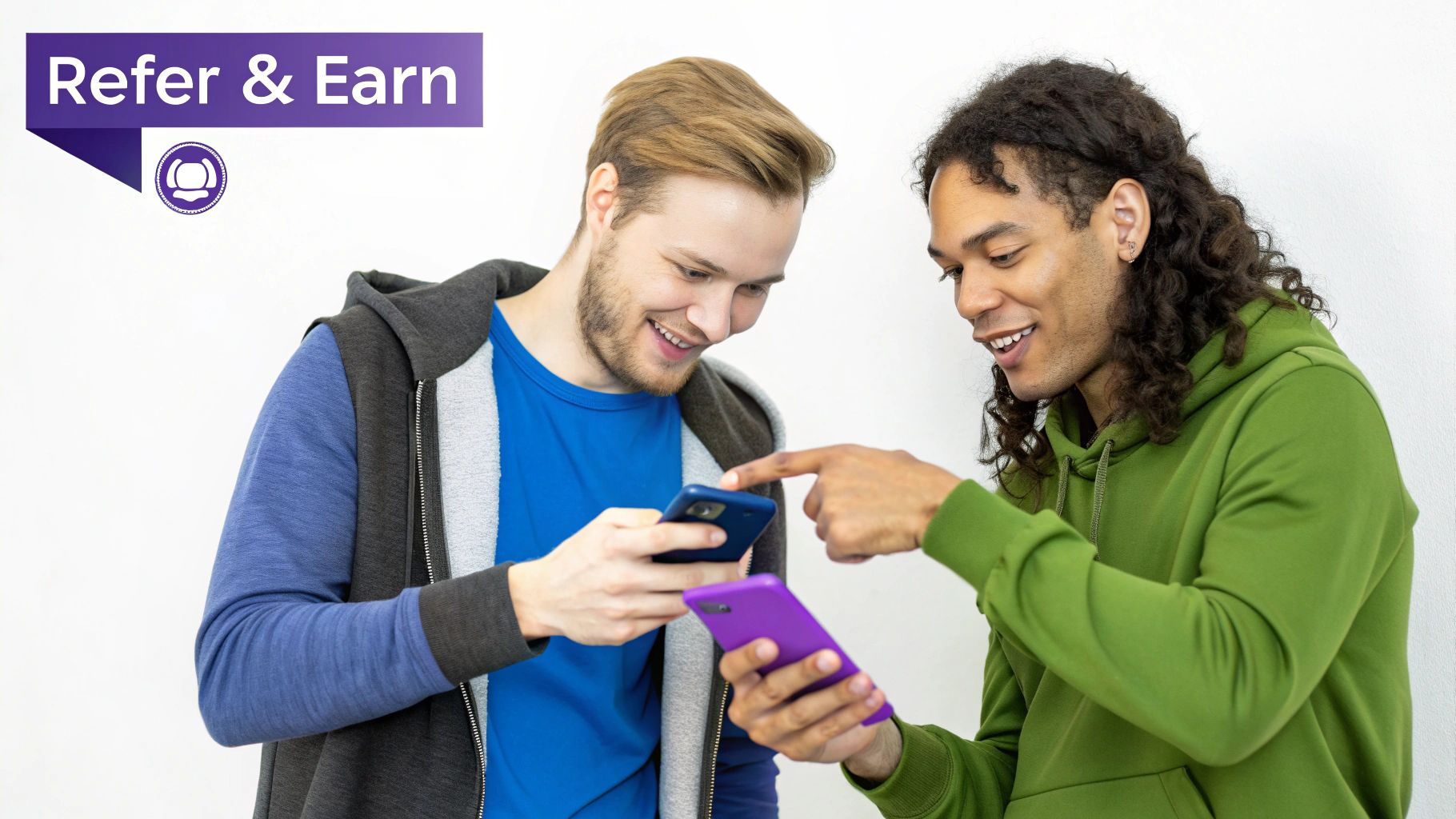
Strategic Breakdown
This workflow leverages your happiest customers to generate high-quality, warm leads at a lower cost than traditional advertising. Companies like Dropbox famously used this model, offering extra storage space to both the referrer and the new user, which fueled their explosive growth. The automation handles the critical touchpoints, such as sending a "thank you" email to the referrer when a friend signs up and enrolling the referred prospect into a tailored welcome sequence. This creates a positive feedback loop that builds brand loyalty and drives new business.
Actionable Takeaways
To build a successful referral program, focus on simplicity and motivation.
- Make Sharing Frictionless: Provide users with a unique, one-click referral link and pre-written social media or email templates to simplify the sharing process.
- Offer Compelling, Two-Sided Rewards: Motivate both parties by offering a benefit to the referrer (e.g., account credit) and the new user (e.g., an initial discount). This dramatically increases participation rates.
- Automate Reward Fulfillment: Trigger reward delivery automatically once the referred user completes a key action, such as making a purchase or signing up for a trial.
- Promote at Peak Satisfaction: Trigger referral program prompts after a customer has a positive experience, like receiving their order or giving a high satisfaction rating.
10. Segmentation and Preference-Based Workflow
A segmentation and preference-based workflow is an automated system that dynamically groups your audience based on specific criteria like demographics, behaviors, and explicitly stated preferences. Instead of a one-size-fits-all approach, this workflow delivers tailored content, offers, and communications to each distinct segment. The core principle is to enhance relevance by aligning the message directly with the recipient's characteristics and interests, making it a cornerstone of effective marketing automation.
Strategic Breakdown
This workflow shifts the focus from mass communication to personalized engagement, dramatically increasing open rates, click-throughs, and conversions. For an e-commerce store, this could mean segmenting customers by purchase history. A user who frequently buys running shoes would automatically receive emails about new athletic arrivals, while another who bought home goods gets updates on kitchenware. This targeted approach is a key part of powerful website personalization strategies, ensuring that every message resonates with the recipient's known interests and past actions.
Actionable Takeaways
To effectively implement this workflow, concentrate on data-driven grouping and continuous refinement.
- Start with Key Segments: Begin with 3-5 core segments, such as "new subscribers," "repeat customers," and "inactive users," before creating more granular groups.
- Use Behavioral Data: Prioritize actions over static demographics. Segment users based on pages visited, products viewed, or features used for more accurate targeting.
- Implement a Preference Center: Allow users to self-segment by giving them a clear and easy way to choose the types of content they want to receive.
- Create Dynamic Segments: Use automation rules to ensure your segments update in real-time. A user should automatically move from "prospect" to "customer" after a purchase.
Comparison of 10 Marketing Automation Workflows
| Workflow | 🔄 Implementation Complexity | 💡 Resources & Data Required | ⭐📊 Expected Outcomes | Ideal Use Cases | ⚡ Key Advantages |
|---|---|---|---|---|---|
| Lead Nurturing Workflow | High — multi-step automations, branching and scoring | Significant: content library, CRM/MA integration, behavioral data | ⭐ High conversion uplift (~+50%); 📊 shorter sales cycles, better lead qualification | B2B SaaS, long sales cycles, lead-to-opportunity motion | Personalization at scale; frees sales; rich lead intelligence |
| Welcome Series Workflow | Low–Medium — simple timed/triggered sequence | Moderate: onboarding copy, signup metadata, templates | ⭐ Better open rates (20–50%); 📊 stronger sender reputation & early engagement | New subscribers, first-time buyers, onboarding flows | Fast value delivery; sets expectations; high initial engagement |
| Re-engagement Workflow | Medium — segmentation + multi-touch sequence | Moderate: engagement history, incentive budget, survey tools | ⭐ Recovers dormant revenue; 📊 improves deliverability and list health | Inactive subscribers/customers, list hygiene campaigns | Cost-effective reactivation; cleans list; insights on disengagement |
| Abandoned Cart Recovery Workflow | Medium — real-time cart triggers and dynamic content | Moderate–High: e‑commerce integration, product feeds, images | ⭐ Recovers 10–30% of carts; 📊 high ROI (often 10–20x) | Online retail, shopping cart platforms, DTC brands | Rapid revenue recovery; addresses checkout friction with urgency |
| Birthday/Anniversary Workflow | Low — date-based triggers, simple personalization | Low: accurate date fields, basic creative, offer setup | ⭐ Higher opens/CTRs; 📊 boosts loyalty and repeat purchase rates | Retail, hospitality, loyalty programs, consumer brands | Emotional, timely outreach; simple setup; strong relevance |
| Post-Purchase Follow-up Workflow | Medium — sequenced onboarding + support content | Moderate: order/shipping data, product guides, support content | ⭐ Improves satisfaction & adoption; 📊 drives reviews, cross-sell and retention | E‑commerce, SaaS onboarding, product-centric brands | Reduces churn/support needs; increases lifetime value |
| Event-Triggered Workflow | High — real-time event tracking and branching logic | High: tracking infra/CDP, developer support, clean events | ⭐ Very high relevance; 📊 2–5x conversion vs. standard campaigns | Intent-driven outreach (e‑commerce, SaaS, content sites) | Contextual timing; superior personalization and engagement |
| Lead Scoring & Qualification Workflow | High — modeling, thresholds, routing automation | High: historical CRM data, analytics, sales–marketing alignment | ⭐ Improves sales efficiency; 📊 predictable pipeline and conversion rates | B2B, enterprise, account-based strategies | Objective qualification; optimizes sales time allocation |
| Referral Program Workflow | Medium — tracking links, reward fulfillment, automation | Moderate: referral system, reward budget, fraud monitoring | ⭐ Higher LTV referrals; 📊 lower CAC and higher conversion | Consumer apps, subscription services, network-effect products | Viral acquisition; high-quality, lower-cost customers |
| Segmentation & Preference-Based Workflow | Medium–High — dynamic segments and preference center | High: clean customer data, preference center, analytics | ⭐ Improves relevance (>20% open gains); 📊 reduces unsubscribes, increases ROI | Any business aiming for personalized messaging at scale | Tailored content delivery; respects preferences; better engagement |
From Examples to Execution: Your Next Steps in Automation
We've journeyed through ten distinct marketing automation workflow examples, from nurturing new leads to re-engaging dormant subscribers and recovering lost sales. Each example, whether it’s a post-purchase follow-up or a sophisticated lead scoring system, reveals a fundamental truth: automation is not about replacing human connection. It's about scaling it. The true power lies in using triggers and data to deliver the right message to the right person at precisely the right moment.
The common thread weaving through every workflow we analyzed is the strategic use of personalization powered by user behavior. An abandoned cart workflow succeeds because it addresses a specific action (leaving a checkout page) with a highly relevant solution. A welcome series builds trust because it acknowledges the user’s initial interest and guides them forward. These aren't just technical processes; they are structured conversations that guide customers through their lifecycle with your brand.
Key Takeaways for Immediate Action
To transition from inspiration to implementation, focus on these core principles derived from the examples:
- Start with Impact: Don't try to build all ten workflows at once. Identify the single biggest leak in your marketing funnel. Is it cart abandonment? Low lead conversion? Fix that one problem first. A single, well-executed workflow can deliver a significant ROI and build momentum for future projects.
- Data is Your Trigger: The most effective automation is not scheduled, it's triggered. Every click, page view, and purchase is a data point. Use tools like Divi Areas Pro to turn these behaviors into triggers for dynamic content like popups, inline sections, or targeted offers that feel personal and timely.
- Segment and Personalize: The segmentation and preference-based workflow isn't just one example; it’s a philosophy that should be applied to all others. Use tags, custom fields, and purchase history to segment your audience. This allows you to create variations of each workflow that speak directly to different customer needs, dramatically increasing engagement.
Building Your Automation Flywheel
Think of each workflow not as an isolated task but as a gear in a larger machine. Your welcome series can identify highly engaged leads, which your lead scoring workflow then qualifies for sales. A post-purchase workflow might identify a loyal customer, automatically enrolling them into a referral program workflow. This interconnected system creates a self-propelling flywheel that continuously enhances the customer experience and drives growth.
The marketing automation workflow examples in this article provide a blueprint. The real work begins now: choosing your starting point, defining your triggers, crafting your content, and measuring the results. Remember, the goal is progress, not perfection. Launch your first workflow, analyze the data, and iterate. This iterative process is the key to building a robust and highly effective automation strategy that works for your specific business and audience.
Ready to bring these automated workflows to life on your Divi site? The powerful conditional logic and trigger-based display features of Divi Areas Pro, created by Divimode, are designed specifically for this purpose. Stop just imagining these powerful automations and start building them today at Divimode.
